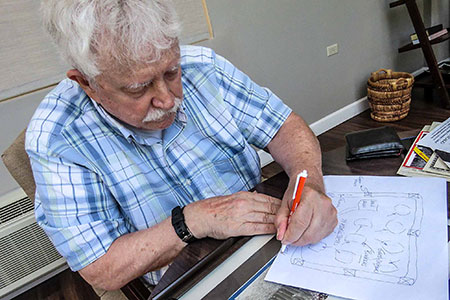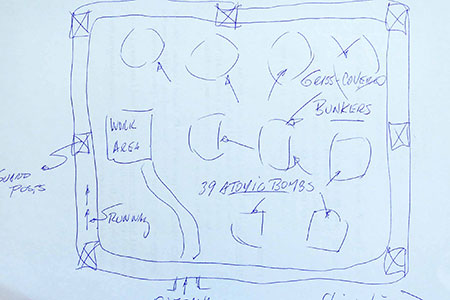Air Force Korean War Schaumburg, IL Flight date: 07/20/22
By Carla Khan, Honor Flight Chicago Veteran Interview Volunteer
USAF A-1C, Fusing Systems Specialist James D. Cook was born in a coal miners’ camp in West Virginia, sometime between the two world wars. James lived with his mom and dad, a coal miner, until he was 5 years old. They moved to Coal City, WV, where James attended a school with all 12 grades in one building. He was a good student who upon graduation was accepted at West Virginia University to study Aeronautical Engineering. James said he’d always been interested in aviation and the fact that the University was close to the Chuck Jaeger Airport clinched the deal. After two years, however, James ran out of money to pay for tuition. At the same time his draft number had come up, so James decided that enlisting in the USAF was a good option since his ultimate goal was to become a pilot anyway.
During Basic Training at Sampson AFB, NY, James aced all his tests. Instead of going to flight school, he was asked if he would consider joining a brand-new unit called “Special Weapons” that dealt with nuclear weapons. This was an offer too intriguing to turn down and James left for Keesler AFB in Biloxi, MS for 6 months of electronics training. The students learned about the differences between exploding and imploding devices and how their release would affect the plane that released them. They learned how to choose systems and how those were composed. They also witnessed one demonstration from 1,000 yards away although the real testing had been done in New Mexico and Nevada.
The class consisted of 30 students from all branches of the military, 29 of which would get domestic deployments; only one would go overseas. The student with the highest score had the first choice but he was getting married and requested state-side deployment. James who had the second highest score was the lucky one who got to go overseas. He even received cash offers if he wanted to trade but he was thrilled with his new assignment and couldn’t wait to go.
The flight across the Atlantic was interesting because the 4-engine military passenger aircraft had its seats facing backwards so that in case of a crash you’d have a better chance of surviving, as James was told. They flew via Labrador to Prestwick, Scotland from where James took the train to London. Since he was in uniform and flying under orders, all he needed to show was his pass. He did not have to buy tickets anywhere for public transportation.





His final destination was the Upper Heyford AFB in the UK where he joined the 1st Aviation Depot Squadron, a part of the 7th Air Division, U.S. Strategic Air Command. The base was old, built in 1918 for the British Royal Air Force with barracks in which the U.S. Airmen were housed in the late 1950’s. James’ wardrobe was somewhat limited, he remembered, because the bag with his civilian clothes was lost and didn’t turn up till 3 months later. His job, however, was very interesting. He needed two special badges, one to clear him for flightline entrance and the other gave him top secret clearance because of the nature of his work.
His job was to determine the height of potential shell airburst by monitoring barometric pressure. As a fusing specialist, James said, he had to go preflight into the cockpit to set all the required procedures so that the pilot, if needed, only had to press one button to release and detonate the explosive device. Often, the ordnance was carried by bombers such as the B-47, B-52, and B-36. The bombs were stored in underground bunkers and had to be towed, disguised in canvas bags, to the planes. Other times, a bomb would be attached to a fighter, particularly the F-84, the first fighter plane to carry bombs.
Because this was during the Cold War, U.S. aircraft were not allowed to fly over countries behind the Iron Curtain. The English didn’t know there were atomic weapons on board; the planes were routed south of Spain and Gibraltar and then north along the Iron Curtain. This re-routing required extra fuel for which special tanks had been attached to the F-84’s. One tank, however, was not a fuel tank but a bomb in disguise. Secretly, special care had to be taken in order to ensure that the weight and balance of the aircraft were not compromised.
A typical day for James consisted of getting up at 6 AM, breakfast at 6:30 and being at the site at 7 AM. The routine was not unpleasant.
Days off were a real pleasure and adventure for James stationed in the UK. Although having grown up in West Virginia coal-mining country, he said he’d never been interested in country music. As luck would have it, he was stationed only 14 miles away from Oxford where he could indulge in cultural events at any of its 39 colleges (some dating back as early as the 13th century). As his ancestors had emigrated from England to America in 1609, James felt an immediate connection with his “old country.” Twice a month, he’d take the train to London and enjoyed visiting as many museums and attending as many concerts as he could. As a 21-year-old American serviceman, he usually felt a little out of place among the audience but no one ever asked him about it. His first and most memorable concert was at the Royal Festival Hall where he heard Arthur Rubinstein play. At that moment, he vowed to himself that if he ever had any children, they’d become classical musicians.
Through a new Air Force friend, Alvin Smith, James met an English family that was very involved in cultural events. They introduced the coal-miner’s son from West Virginia to opera, ballet, and classical concerts. And, looking back, James said, this kind of exposure to a different world enriched and changed his entire life.
In his spare time, James also pursued his dream of becoming a pilot and he obtained a license to fly a bi-plane. Before returning to the USA, James had the opportunity to sail for a week with friends down the River Thames. Finally, he topped it off with a visit to Paris to see the Eiffel Tower, the Arc de Triomphe, and the Louvre Museum. He feels that his overseas experiences made him a “citizen of the world.”
When his service time was up, it was time to go home; however his parents had moved to Chicago which became his home. James used the G.I. Bill to complete his education by attending IIT (Chicago), Chicago State University (Chicago), and Northwestern University (Evanston, IL) earning his B.S. in Science.
His military experience helped him get employment at Argonne National Laboratory in Atomic Energy Research and the Whiting Corp. in Harvey, IL working on Nuclear Submarine Reactor Installation and Removal Equipment Design.
James is now enjoying his retirement. He has 4 daughters, the oldest of whom, true to his dream, became a classical musician. They all live in the Chicago area and often visit him along with his 5 granddaughters.
James, thank you for your service and enjoy your well-deserved Honor Flight.


